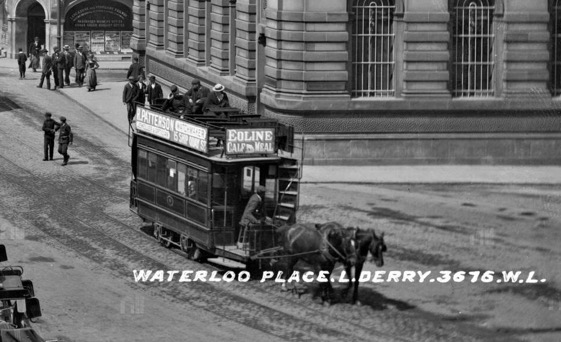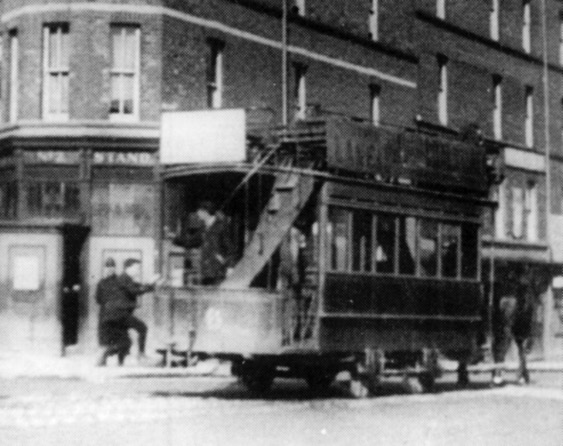City of Derry Tramways
History
Derry's horse-drawn tramway system was promoted by a number of local luminaries, who successfully approached Derry Corporation on the 25th July 1892, gaining their support on the proviso that steam traction would not be used. At some point, it is unclear when, the promoters formed a company — the City of Derry Tramways Company — to finance, build and operate a standard-gauge tramway, and applied for an Order-in-Council (from the Privy Council of Ireland) on the 3rd September 1892, which was granted on the 30th March 1893. This was quickly followed up by an application for an extension to the original tramway, though it was not to be granted for another four years. The company meanwhile issued a share prospectus in order to finance the tramway; this, however, proved to be a complete failure, only 5% of the shares being taken up, leaving the scheme high and dry.
Nothing more was done until early 1896 when the contractors, John McFarland and John McCrea, offered to build and equip the tramway in exchange for shares in the company. Construction started on the original line on the 12th November 1896, the first public tramcar service running some 5 months later on the 31st March 1897. The company quickly applied for a grant of the Order-in-Council for the extension, which the corporation had previously supported, but now objected to. Despite this objection, the order was granted on the 8th May 1897, the extension opening on the 3rd December 1897. This took the tramway to its final extent of just 1.51 miles.
The line commenced at the Londonderry and Loughswilly Railway Company's station on the west bank of the River Foyle at Graving Dock, running southwards along Strand Road to Shipquay Place (the original terminus), then continuing southwards along Foyle Street to a terminus opposite Carlisle Bridge, and close to the Great Northern Railway (of Ireland)'s Foyle Road Station.
The company was now controlled by McFarland and McCrea, who between them owned over 90% of the shares. The following year, both Dick Kerr & Company (well-known tramway contractors) and the New General Traction Company (the owners of Coventry Electric Tramways) entered a dialogue with McFarland with a view to acquiring the tramway and converting it to electric traction. Although agreement was reached for the latter to buy the tramway, the scheme ultimately failed on the alter of municipal obduracy, the corporation refusing to sell its loss-making and recently built generating station to the NGTCo, without which the NGTCo withdrew. Another suitor appeared the following year (1899), this time the British Thomson-Houston Company (owner of Cork Electric Tramways), though its interest seems to have quickly waned. The corporation got one last chance to reconsider its stance in August 1906 when it was approached by J G White & Company (tramway contractors and operator of Dartford Council Light Railways); although this time it decided to pursue the offer, JGW&Co evidently got cold feet, so the city was destined never to have an electric tramway.
The horse tramway continued to ply its trade, returning modest profits (with the odd small loss) until the advent of the Great War, when the concern entered the red and stayed there. A major blow came on the 30th July 1918 when the corporation obtained powers to run trolleybuses and motorbuses, despite objections from the tramway company. The final blow came in January 1919 with a pay claim from the Amalgamated Union of Labour, which threatened a strike, even though it was well aware that the company made a loss. The response of the company was to advertise an auction of its assets, which took place on the 5th of February 1919, services presumably having been withdrawn shortly beforehand.
Uniforms
Photographs depicting City of Derry tramcars are very scarce indeed, and those which have survived only show the men working the vehicles indistinctly, and at a distance. They suggest, but by no means prove, that staff wore informal attire, i.e., robust jackets, shirts and ties, along with the fashionable headgear of the day, either the bowler hat or the flat cap. No badges of any kind, including licence badges, appear to have been worn.
In 1901, the company employed eight drivers, eight conductors and one inspector. It is unclear whether or not the inspector was issued with a uniform, as neither photographs nor documentary evidence have survived.
Further reading
For a history of the system, see: 'The City of Derry Tramways' by A T Newham, in the Tramway Review, Nos 70 (p168-178) and 71 (p195-200); Light Railway Transport League (1972). For an overview of the Irish tram scene, including the City of Derry Tramways, see 'Irish Trams' by James Kilroy; Colourpoint Books (1996).
Images
Horse tram drivers and conductors
An enlargement of a superb photograph of Waterloo Place, depicting a nicely turned-out, two-horse tramcar with the driver, gazing backwards, clearly in informal attire, wearing a flat cap — photo undated, but probably early Edwardian. Original photo believed to be by Robert French, and held in the National Library of Ireland.
A rather care-worn Tramcar No 6 in John St, with the conductor (on the rear platform) observing a rather keen passenger, mid-leap — photo undated, but probably taken in the second decade of the 20th Century judging by the fashions and the condition of the vehicle. Photo courtesy of the Tramways and Light Railway Society, with thanks to David Voice.